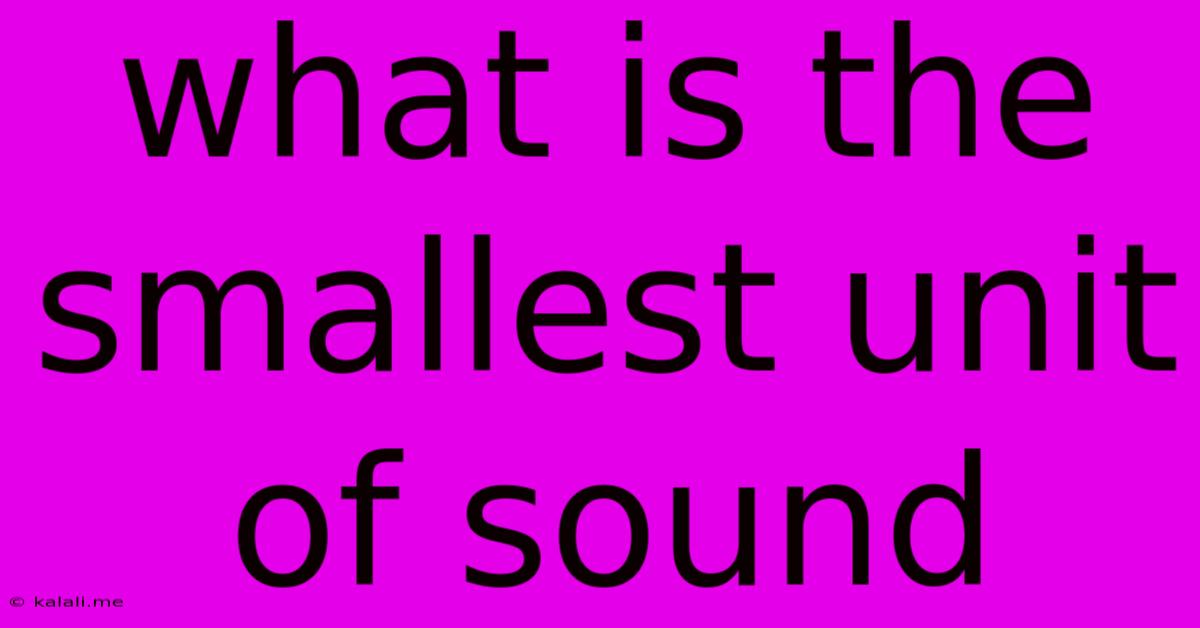What Is The Smallest Unit Of Sound
Kalali
Jun 15, 2025 · 3 min read

Table of Contents
What is the Smallest Unit of Sound? Understanding Phonemes in Linguistics
Have you ever wondered what makes the sounds of human speech unique and understandable? The answer lies in the smallest unit of sound, a fundamental concept in linguistics known as a phoneme. This article delves into the fascinating world of phonemes, exploring their definition, characteristics, and significance in language acquisition and processing.
The smallest unit of sound that distinguishes meaning in a language is a phoneme. This means that changing a single phoneme within a word can completely alter its meaning. For example, the words "cat" and "bat" differ by only one phoneme – the initial consonant sound. While seemingly simple, understanding phonemes is crucial to grasping how humans produce and comprehend spoken language.
What makes a phoneme a phoneme?
A phoneme isn't simply any sound you can make; it carries a specific distinctive feature that separates it from other sounds within a language. These features can include:
- Voicing: Whether the vocal cords vibrate (voiced, like /b/) or not (voiceless, like /p/).
- Place of articulation: Where in the vocal tract the sound is produced (e.g., lips, teeth, tongue).
- Manner of articulation: How the airflow is constricted (e.g., stopping, frication, nasalization).
These features work together to create a unique acoustic fingerprint for each phoneme. It's important to note that the same phonetic sound can be represented differently across different languages. The written representation of sounds (graphemes) also doesn’t always match perfectly to phonemes, leading to complexities in spelling and pronunciation.
Phonemes vs. Allophones: A subtle distinction
It's crucial to differentiate phonemes from allophones. Allophones are variations in the pronunciation of a phoneme that don't change the meaning of a word. For instance, the /p/ sound in "pin" and "spin" might be slightly different, but they both represent the same phoneme. The variation is due to the surrounding sounds and isn't a meaningful distinction. Phonemes are the abstract units, while allophones are their concrete realisations in speech.
The significance of phonemes
Understanding phonemes is vital for several reasons:
- Language Acquisition: Infants learn to distinguish and categorize phonemes during language development. This ability forms the foundation for word recognition and sentence comprehension.
- Speech Therapy: Speech therapists use their knowledge of phonemes to diagnose and treat speech disorders. Identifying difficulties in producing or perceiving specific phonemes is key to effective intervention.
- Computational Linguistics: Phoneme recognition is a core component of speech recognition technology, enabling computers to understand and process spoken language.
- Foreign Language Learning: Recognizing and mastering the phonemic inventory of a new language is critical for achieving fluency in pronunciation and comprehension.
Conclusion: The building blocks of language
Phonemes, the smallest units of sound that distinguish meaning, are fundamental to the structure and function of human language. Their study provides valuable insight into how we learn, process, and use language, impacting fields from speech therapy to artificial intelligence. By understanding the intricate details of phonemes, we gain a deeper appreciation for the complexity and beauty of human communication.
Latest Posts
Latest Posts
-
Which Of The Following Is A Non Renewable Resource
Jun 15, 2025
-
What Is A Major Element Found In Bones
Jun 15, 2025
-
What Is The Storage Form Of Glucose In Plants
Jun 15, 2025
-
Which Is Heavier Kilograms Or Pounds
Jun 15, 2025
-
Identify The True And False Statements About Survey Research
Jun 15, 2025
Related Post
Thank you for visiting our website which covers about What Is The Smallest Unit Of Sound . We hope the information provided has been useful to you. Feel free to contact us if you have any questions or need further assistance. See you next time and don't miss to bookmark.